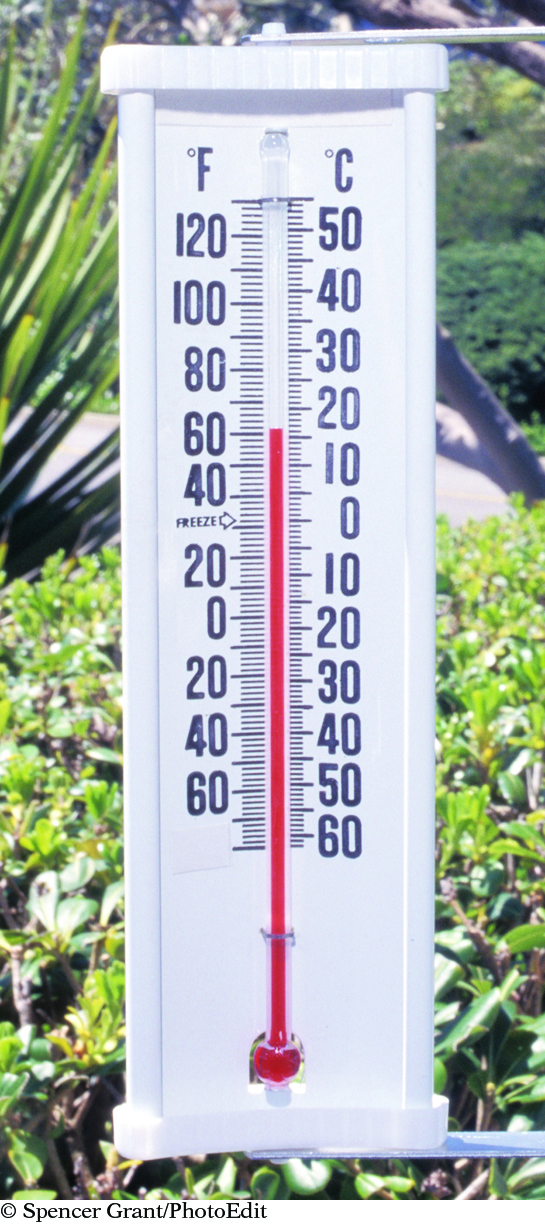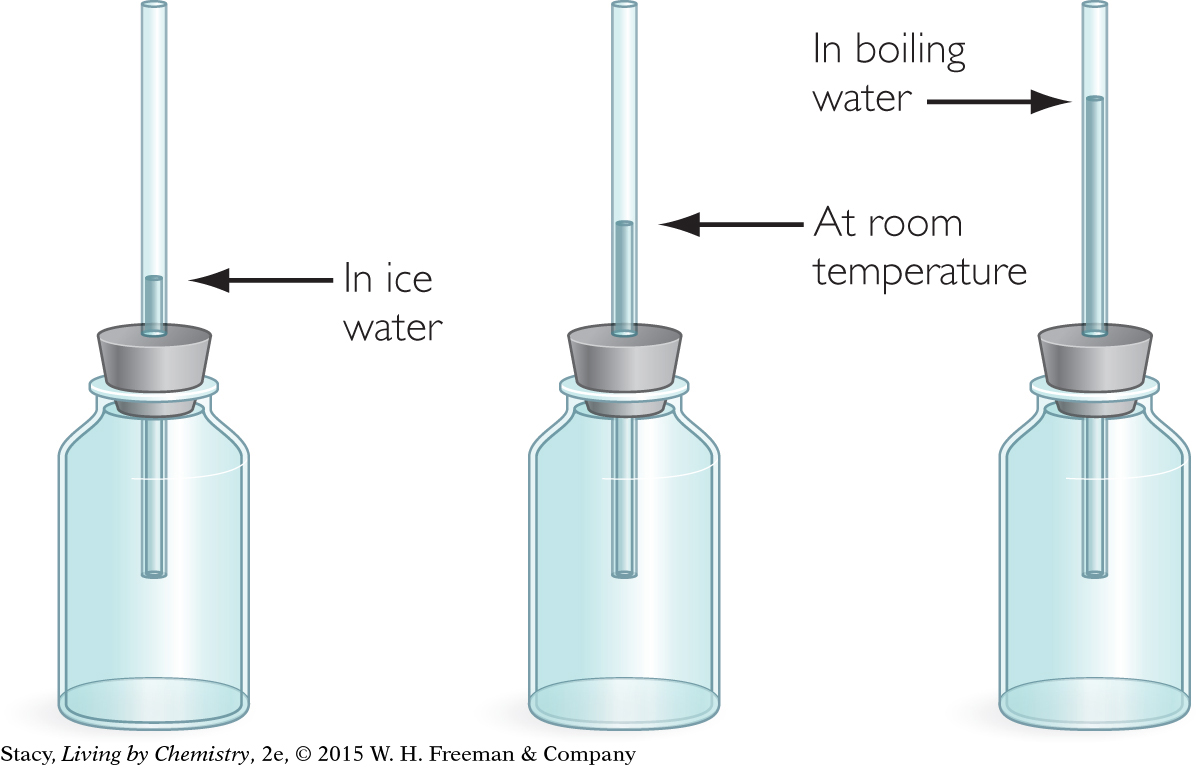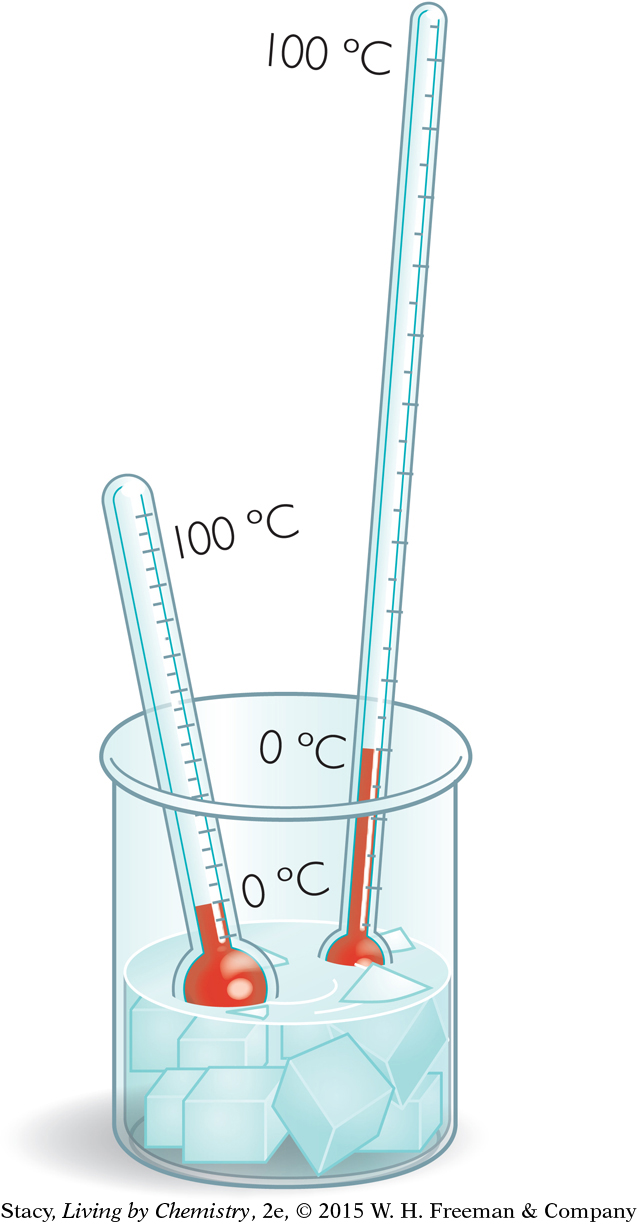LESSON 52: Hot Enough: Thermometers
273
THINK ABOUT IT

On a single day, a thermometer in Anchorage, Alaska, might read –15 degrees, while a thermometer in Sydney, Australia, reads 35 degrees, and a thermometer in your classroom reads 68 degrees. It is interesting to consider how a small glass tube with some red liquid inside can indicate how hot or cold it is.
How is temperature measured?
To answer this question, you will explore
Changes in Volume
Creating Temperature Scales
Fahrenheit Versus Celsius
Changes in Volume
EXPLORING THE TOPIC
Changes in Volume

Matter responds to increasing temperature in a variety of ways. A wad of bubble gum gets softer, a “mood” ring changes color, and the air in a balloon expands. By systematically tracking any one of these changes, you could make a thermometer.
However, to make a good thermometer, it is better to track a physical change that is reproducible and easily measurable.
One way to make a thermometer is to fill a thin glass or plastic tube with a liquid. As the liquid in the thermometer is heated, its volume and height increase. As the liquid is cooled, its volume and height decrease. Because volume and height are proportional, you can detect the increase in volume as an increase in height.

274
HISTORY CONNECTION
HISTORY
CONNECTION
The first liquid thermometers were constructed with liquid mercury. Mercury is a good choice because it remains a liquid for a wide range of temperatures. Alcohol is another good choice. In contrast, water is not a good choice because it can freeze in the thermometer and expand, breaking the glass.

GAS THERMOMETERS
Gases also expand and contract upon heating and cooling. A gas thermometer requires a container with a flexible volume. Suppose you have a sample of air in hot water trapped in an inverted graduated cylinder. If you heat the trapped air sample, some of the air will bubble out of the cylinder. This is evidence that the air is expanding. If you cool the trapped air sample in ice water, water will rise into the cylinder. This is evidence that the air sample contracts as it cools, leaving room for some water to move up into the cylinder. The expansion and contraction of air is important in understanding the weather.

Big Idea
Big Idea
Most matter expands in volume as it is heated and contracts as it is cooled. In solids, the change is usually very small. In gases, the change is dramatic.
Creating Temperature Scales
Creating Temperature Scales

To make a thermometer, you could put a colored liquid in a glass or plastic tube. Then you need to construct a scale, or number line, on the tube to assign numbers to different temperatures. You can construct a scale by measuring two temperatures, such as the boiling point and freezing point of water. It is typical to measure water because water is easily accessible and always boils and freezes at the same temperatures at sea level.
The temperature at which a substance melts or freezes is called the melting point, or the melting temperature. The temperature at which it boils or condenses to a liquid is called the boiling point, or the boiling temperature. Each time you measure the height of the liquid at the melting point and boiling point of water, you will get the same two heights on your thermometer.
Once you have two marks, you can divide the length between the marks into a round number of intervals. Each interval is one unit of temperature. The intervals provide numerical values for other temperatures besides the melting and boiling points of water. For instance, you can use your thermometer to measure the room’s temperature. Someone else who makes a thermometer using the same points and intervals that you used will be using the same scale, and you can accurately compare temperatures.
Fahrenheit Versus Celsius
Fahrenheit Versus Celsius
275
One commonly used temperature scale is the Celsius scale. This scale sets the melting temperature of ice at 0° and the boiling temperature of water at 100° as measured near sea level as opposed to in the mountains (water boils at a lower temperature when you are at higher altitudes). This scale uses degrees Celsius, °C, as units. The Swedish astronomer Anders Celsius created this temperature scale in 1747. Most of the world and most scientists use the Celsius temperature scale.
In contrast, a weather report in the United States gives temperature in degrees Fahrenheit, °F. German physicist Daniel Gabriel Fahrenheit had proposed his temperature scale in 1724. On the Fahrenheit scale, the melting temperature of ice is 32 °F and the boiling temperature of water is 212 °F.

There are 180 Fahrenheit degrees between 0 °C and 100 °C. This means that a Fahrenheit degree unit is a smaller change in temperature than a Celsius degree unit.
In this course, you will use the Celsius scale. It is useful to know how to convert between the two scales. The formula given here allows you to convert from degrees Celsius, C, to degrees Fahrenheit, F.
[For review of this math topic, see MATH Spotlight: SI Units of Measure on page A-0.]
276
Example
Weather Forecast
The weather forecast in Tokyo, Japan, calls for a 60% chance of precipitation with temperatures reaching 30 °C, while in Washington, D.C., the weather forecast calls for a 70% chance of precipitation with temperatures reaching 50 °F.
Which city will be warmer? Justify your answer by converting the temperatures to the same scale.
Assuming that there is precipitation in each of these cities, will rain or snow be seen in each place? Explain your thinking.
Solution
To compare temperatures, you convert them to the same scale.
You can convert 30 °C to °F:

Substitute the known value. 
Solve for the unknown value. F = 86 So, 30 °C = 86 °F. You could also convert 50 °F to °C:
Tokyo is warmer because 86 °F (30 °C) is higher than 50 °F (10 °C).
Because ice and snow melt at 32 °F (0 °C), you would expect rain rather than snow in both cities.
LESSON SUMMARY
LESSON SUMMARY
How is temperature measured?
KEY TERMS
melting point (melting temperature)
boiling point (boiling temperature)
Matter changes volume in response to changes in temperature. Matter generally expands when heated and contracts when cooled. This property can be used to measure temperature: The volume of liquid in a thermometer changes as the temperature changes. To set a temperature scale, you need to start with at least two points. Once these two temperature points are noted on a scale, it is possible to figure out where any other temperature would be on that scale.
Exercises
Reading Questions
Explain how the height of a liquid can be used to measure temperature.
Describe in your own words how to construct a temperature scale.
Reason and Apply
What are the advantages of the Celsius temperature scale over the Fahrenheit temperature scale?
277
When the temperature is 0 °C, is it also 0 °F? Explain.
Convert –40 °C to °F. Show your work.
Which is larger: one Celsius degree or one Fahrenheit degree? Explain.
The doctor tells you that your body temperature is 40 °C. Are you sick? Show your work and explain your answer.
You will be traveling to Hawaii where the forecast is for a temperature of 31 °C during the day, dropping to 28 °C overnight. Your friend recommends that you bring clothing for warm weather. Is this a good recommendation? Why or why not?
Create a graph comparing the Celsius and Fahrenheit scales.
Plot the freezing point and the boiling point of water on your graph. Draw a straight line connecting the two points.
Use the graph to determine the temperature in °F when it is 10 °C.
If the weather forecast says it is 55 °F in Washington, D.C., what is the temperature in °C?